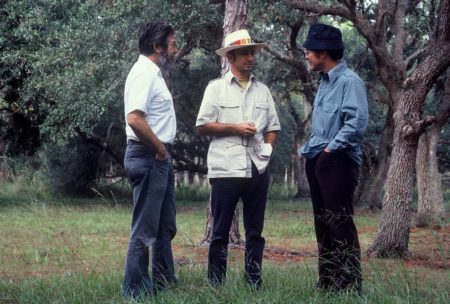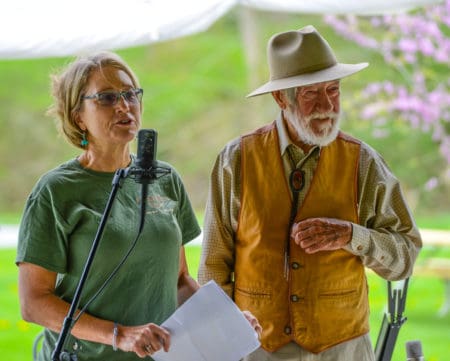AHS Co-founder Inducted into AT Hall of Fame
I was honored to sit down recently with 90-year-old AHS co-founder and founding editor of Backpacker Magazine, Bill Kemsley. Bill joined me over video call from his home in Taos, NM, to share reflections on hiking after his May 4 induction into the Appalachian Trail Hall of Fame, hosted by the Appalachian Trail Museum. This hiking legend still hikes every day on one of the 30 trails within 20 minutes of his front door, and he’s an avid writer of books and blogs, much of it centered around the influence of the outdoors on philosophy. Clearly, hiking has been key to his physical and mental longevity!
Kate: What do you remember about your early hiking experiences and how have they shaped you as a person?
Bill: Before there was radio, before there was TV, in my childhood in Michigan, we spent Sundays going for a picnic and then a hike -- but we just called it a “walk in the woods”. Hiking gets in your blood. It’s impossible to replicate. The closest experience I can think of is walking into the Notre Dame cathedral in Paris -- that awe you have as you walk through the door. My father said of the sun coming down through the pines, “This is the cathedral of the pines.” That is my relationship with God.

From left to right, AHS co-founders Bill Kemsley, Jim Kern, and Paul Pritchard meeting to form the first national voice for hikers in 1976.
Kate: Take us back to 1976. Why did you think there was a need then for an organization like AHS?
Bill: Back in the early ‘70s, the Appalachian Trail was in major crisis. Everyone wanted to hike it, but it had 700 miles of gaps. Shortly after I started Backpacker magazine in 1973 I got a call from Destry Jarvis of the National Parks and Conservation Association to testify before the 1974 Senate Appalachian Trail Oversight hearings. I called every hiking club up and down the Appalachian Trail as well as every conservation organization you can name to send representatives to testify.
Jim Kern, the founder of the Florida Trail, was the only volunteer to show up. Along with Paul Pritchard, then Executive Director of the Appalachian Trail Conservancy, and Destry, we were the only ones at those hearings.
Jim, Paul and I got together right afterward and decided that a national organization of hikers was needed to look out for trails at the federal level. So we founded the American Hiking Society in 1976.
Since the Appalachian Trail was in crisis, with developers laying out plans for building sites on the 700 miles of gaps on the trail, we gave it a heavy effort.
Paul Pritchard became Assistant Secretary of the Interior. Through Paul, we managed to obtain $35 million in 1977 to begin acquiring lands to fill the 2550 gaps on the AT.
Meanwhile, Paul, also being a friend of Maryland’s Congressman Goodloe Byron (D-MD, 1971-1978), with whom he hiked, arranged for the three of us – Jim, Paul and me – to meet with Goodloe. We persuaded him of the AT’s needs and invited him to serve on the AHS board of directors.
Goodloe agreed and proceeded immediately that same year, 1977, to introduce to Congress his amendment to the 1968 AT act, HR-8803, with the promise of our support. Of course, I supported it in every issue of Backpacker magazine until it passed the House 409 to 17 that August 1977, then by the Senate and into law in March 1978. The bill provided $90 million for land acquisition along the AT, the first congressional designated funds for the AT.
Because of my efforts on behalf of the AT at that critical juncture I was inducted into the AT Hall of Fame.
Kate: Jumping back to 2018, why is there still a need for an organization like AHS?
Bill: Only 2 of the 11 National Scenic Trails are contiguous, end-to-end -- the AT and the Arizona Trail, though the latter has some issues with access to some points of the trail. The other trails have 10,000 miles of gaps in them, some of them huge. Jim, Paul, and I (along with a few others) are lobbying for a federal study of the trails to determine what is needed to close the gaps. Each of the trails has different needs. We don’t even know who the hikers are or how many of them there are on the various trails. Beyond the gaps, there are stewardship issues -- people leaving trash, especially on the Appalachian Trail, which is like a “hiking highway” now. I think that getting more attention for the other 10 trails would help take some pressure off the AT. For example, my family just hiked a section of the AZT, and the only local users we saw out there were bikers. Development is the single biggest threat to trails, but I’ve seen local activism work in concert with national advocacy to find a compromise that saves the trail. The number one problem in hiking is to close the gaps in these “Long Trails” before we lose them.

Bill Kemsley being inducted into the Appalachian Trail Hall of Fame, May 5, 2018 (Credit: Dan Innamorato, AT Museum)
Kate: For what do you most want to be remembered in the hiking community?
Bill: Most of my life, certainly 60 years of it, have been spent trying to be as present as I can be, feeling great wherever I am in life. Doing that, I don’t worry about the future or the past. According to the Buddhists, what you do in this life is what matters, so I haven’t thought much about what happens after that. I was shocked about being inducted into the AT Hall of Fame. I was speechless, and I’m not known to be speechless. They showed a video of my life in relation to hiking, with 100 people in the room. I’ve never known anything like that. That’s how I’m being remembered.
Article by Kate Van Waes, Executive Director at American Hiking Society
